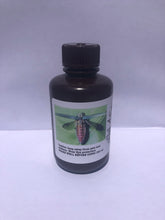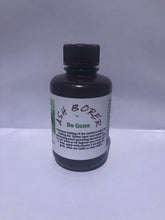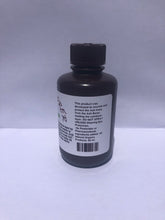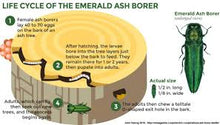
Ash Borer Be Gone is an all natural product with NO pesticides or pharmaceuticals added. You drill 10-12 holes around the trunk of the tree. Drill at a 45 degree angle, 3/4"-1" deep. Use a 1/4" drill bit. Make sure you ream out the drilled holes to allow product to fill the cavity and not run down the side of the tree. Apply about 2 ml per hole till all of product is gone. Use 60 ml per tree, apply for about 3 days in a row. A pipette is included with the product.
Shake well before each application
The healthy ingredients will feed the xylem vascular system to feed the whole tree and especially the phloem and cambium layer where the ash borer creates the damage. This product is best for prevention and if tree is recently infected as the xylem system needs to be in place to feed the tree. After the full application has been applied best to close up the drilled holes with beeswax.

Eggs are laid from mid June and well into August. Female EAB deposit their eggs individually on ash trees, between layers of outer bark and in cracks and crevices of the trunk and major branches. EAB eggs hatch in about two weeks, depending on temperature.
The emerald ash borer (Agrilus planipennis) is a green buprestid or jewel beetle native to north-eastern Asia that feeds on ash species. Females lay eggs in bark crevices on ash trees, and larvae feed underneath the bark of ash trees to emerge as adults in one to two years.

Signs of infestation include thinning and yellowing leaves, D-shaped holes in the bark, and canopy and bark loss.
Emerald Ash Borer: Biology and Life Cycle
The Emerald Ash Borer, Agrilus planipennis Fairmaire (Coleoptera: Buprestidae), commonly referred to as “EAB”, is an invasive wood-boring beetle. Native to Asia, the beetle’s first North American populations were confirmed in the summer of 2002 in southeast Michigan and in Windsor, Ontario. EAB was likely introduced to the area in the mid-1990’s in ash wood used for shipping pallets and packing materials in cargo ships or shipping containers. Emerald ash borers feed on and eventually kill all native ash trees (Fraxinus spp.). Slowing their spread is imperative.
The Emerald Ash Borer (EAB) is a member of a family of insects called metallic wood-boring beetles (Buprestidae). Adult EAB are a brilliant metallic green color. The dorsal side of the abdomen, which can be seen when the wings are spread, is a metallic purplish-red. Adult EAB average 3/8 inch to 3/4 inch (10 mm to 20 mm) long and 1/6 inch (4 mm) wide (males are slightly smaller than females).
Biology and Life Cycle

EAB on leaf, note irregular edges caused by EAB feeding on leaves. Source: David Cappeart, Michigan State University, Bugwood.org
EAB generally have a one-year life cycle, emerging from beneath the bark of ash trees beginning in late-May or early-June with peak activity between mid-June and early-July. They emerge between 450 and 500 growing degree days which coincides with the flowering of black locust, Robina pseudoacacia. Track growing degree days at known EAB infestation locations at the Northeast Regional Climate Center website.
Northeast Regional Climate Center
EAB adult flight season is finished by early August. Adult EAB are most active during the day and favor sunny, warm weather; sheltering in bark crevices or under foliage when it is rainy, windy or cooler. The life span of adult EAB is about 3 weeks.
Adult EAB feed along the margins of leaves, leaving small, irregular shaped edges. Newly emerged adults must feed for at least several days before mating; mated females feed for an additional 1 to 2 weeks before laying eggs (females can mate multiple times; males do not). An “average” female may lay from 60 to 100 eggs during her lifespan, placing the eggs singly in bark crevices or under bark flaps on the trunk or branches (some long-lived females may lay more than 200 eggs).

EAB eggs. Source: David Cappeart, Michigan State University
Eggs hatch in 7 to 10 days. The slightly flattened, white to cream-colored larvae have 10 abdominal segments with the last 3 or four segments resembling bells that are nested one upon the other. This is a good characteristic to use when comparing EAB to other insect larvae that may be found under the bark of ash trees.EAB larvae go through five life stages (instars) with mature larvae reaching an average length of 1 1/2 inches (38 mm). After hatching, the first instar larvae chew through the outer bark and feed in the phloem (the inner bark, the pipeline through which food is passed from the leaves to the rest of the tree) and the cambium (the growing part of the trunk, located between the phloem and the sapwood).
As they feed the larvae wind back and forth, either up or down the stem, creating serpentine (S-shaped) “galleries”, characteristic of this wood-boring beetle. The galleries are filled with “frass”, a fine sawdust-like material. When EAB have finished feeding, the final galleries can extend from 4 inches to 20 inches (10 to 50 cm) in length.
(To distinguish EAB galleries in Ash from galleries of other insects, please see the document “Recognizing Insect Galleries in Ash Trees in Minnesota.”)
Recognizing Insect Galleries in Ash Trees in Minnesota

EAB “galleries.” Source: David Cappeart, Michigan State University
Larval feeding ends in autumn, at which time the fifth instar larvae excavate pupal chambers 1/2 inch beneath the surface of the sapwood and overwinter as pre-pupae. Pupal chambers can also be found
in the outer bark when it is thick enough. Pupation generally takes place the following spring (late-April to May), with adults staying in the pupal chambers for 1 to 2 weeks, at which time they emerge headfirst through a distinctive 1/8 inch to 1/6 inch (3 mm to 4 mm) D-shaped exit hole, beginning the cycle of life over again. The presence of the exit holes typically goes undetected until trees show other, more visible symptoms of being infested.
It should be noted that when EAB is developing in healthy, newly infested ash trees larvae may need an additional year (a 2-year life cycle) before pupating and emerging as adults. As infestations develop and EAB populations increase, the 1-year life cycle becomes the norm.







